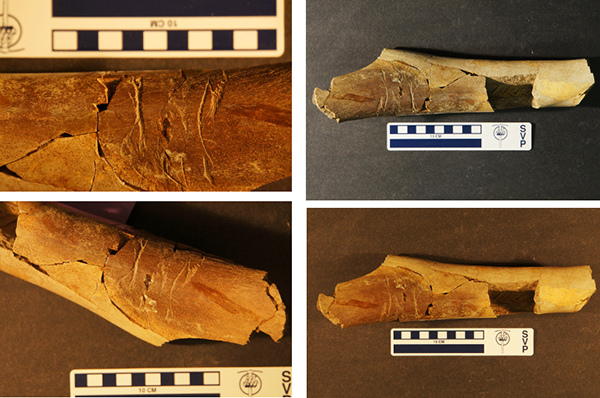
by Timothy Oleson Monday, November 9, 2015

Bite marks seen on this large theropod bone, which was found recently in Wyoming, offer strong evidence that Tyrannosaurus rex wasn't averse to making a meal out of its own kind. Credit: Matthew McLain
Tyrannosaurs were not the most discerning of carnivores. In addition to dining on other dinosaurs, like Triceratops and duck-billed hadrosaurs, it appears the fearsome apex predators weren’t averse to making a meal of their own kind. A series of deep bite marks on a 66-million-year-old leg bone uncovered recently in eastern Wyoming may be the best evidence yet of Tyrannosaurus rex cannibalism.
Upon noticing the bite marks on the bone, “we knew that we had something really special,” says Matthew McLain, a graduate student at Loma Linda University in California who presented an analysis of the features last week at the annual meeting of the Geological Society of America in Baltimore. For example, there are indications on the bone of a tooth “re-entering the same groove,” an indication that the animal that did the biting was “really trying to strip flesh off,” he says. “It really looks like feeding [behavior],” McLain told EARTH.
The bitten bone fragment, pulled from the rocks of the Lance Formation in Wyoming and dating to the Maastrichtian Age shortly before the mass extinction that finished off the nonavian dinosaurs, was large and hollow, indicating it had belonged to a big theropod; T. rex, the largest theropod found in the Lance, was the only animal that fit the bill. And the bite marks suggested the attacking animal was probably as big as or bigger than the victim, McLain says.
To further confirm the aggressor’s identity, McLain and his colleagues turned to studies of bite marks left on bones by modern Komodo dragons, which, like tyrannosaurs, have serrated teeth. That work showed that if a Komodo dragon dragged the serrated edge of its tooth sideways along a bone, as it might if it turned its head abruptly while feeding, it would carve parallel grooves — each no bigger than the size of the tooth serrations — into the bone. “You can measure the distance between those [grooves] and then compare it to the distance between the serrations on the teeth themselves,” McLain says. “And then you can match up which tooth made this mark.”
The bone that McLain and his team found had such parallel grooves, among other marks gouged by teeth, suggesting the animal that left them indeed had serrated teeth and ruling out other possible culprits, like ancient crocodiles, that did not. When the researchers measured the striations and the distance between them, they found that the grooves were too big and too widely spaced to have come from any other dinosaurs that inhabited the area at the time. But they were a match for an adult T. rex tooth.
This isn’t the first evidence that tyrannosaurs in general, and T. rex specifically, might have had cannibalistic tendencies. Previous studies have described tyrannosaur bones — from 75-million-year-old Daspletosaurus, for example — bearing bite marks that could have come from kin. The difference between most of the earlier indications and this new work is the number of markings found on a single bone, McLain says, and thus the strength of evidence for T. rex cannibalism. Instead of one or two bite marks per bone, “on this [bone] we have something like eight to 10, and they’re all concentrated in one spot in the same direction.” This reinforces the notion that the one dinosaur was actually eating the other, rather than the marks simply representing injuries sustained during combat.
Although the prospect of two T. rexes locked in an eat-or-be-eaten battle is thrilling, McLain says there’s no way to tell in this case if the dinosaur that did the biting actually killed its fallen companion before chomping away or if it was simply scavenging the carcass of an animal that died by other means. He says, however, that continuing efforts may help confirm what part of the animal the bone came from — the researchers suspect it’s a lower leg bone — as well as the size difference between the two animals. “There might be a story to tell there too about relationships between bigger and smaller tyrannosaurs.”
© 2008-2021. All rights reserved. Any copying, redistribution or retransmission of any of the contents of this service without the expressed written permission of the American Geosciences Institute is expressly prohibited. Click here for all copyright requests.